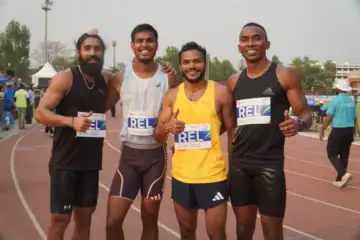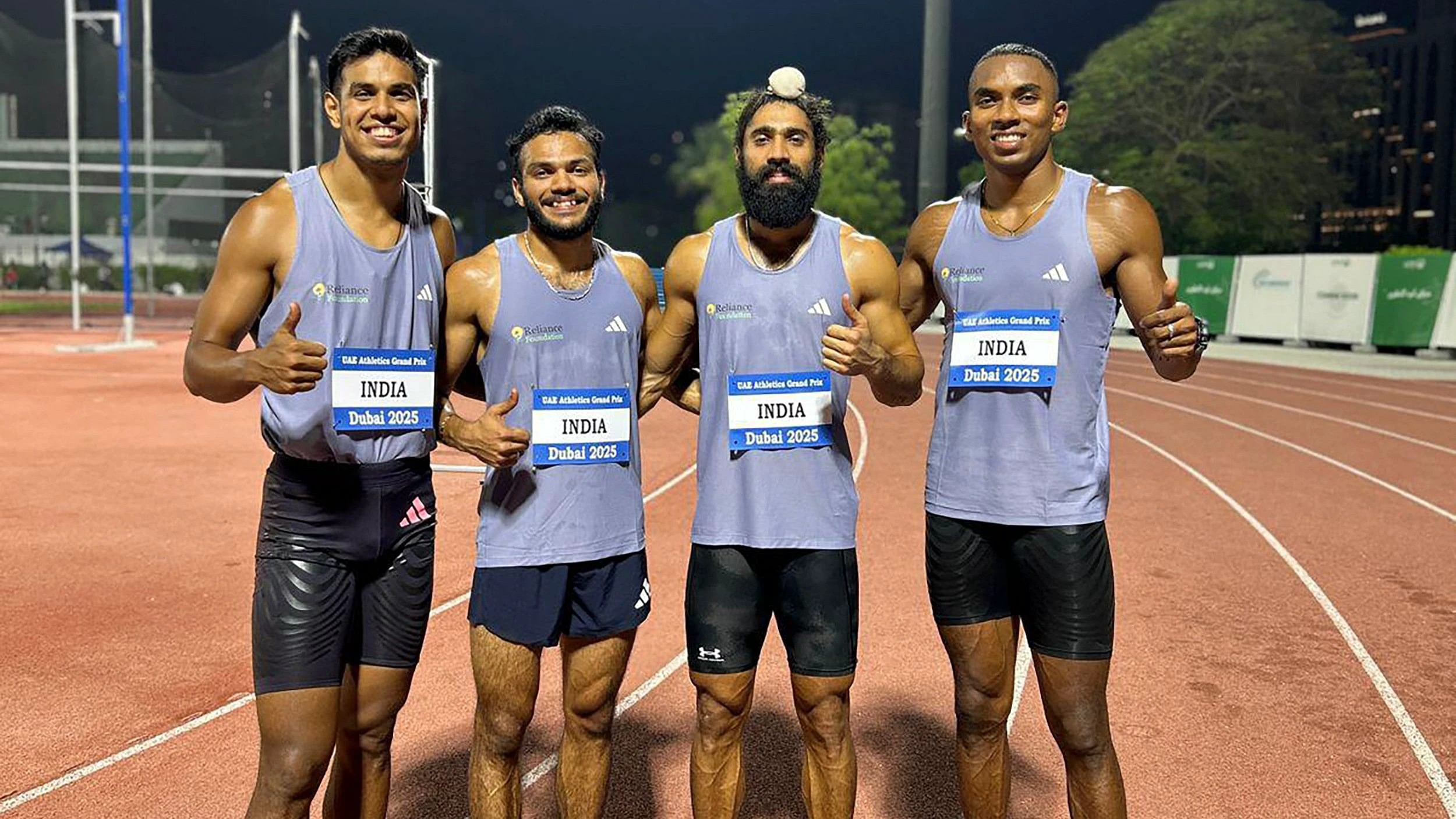Bengaluru: Lights. Camera. Action!
Wait, hold that thought. This isn’t a dive into the glitz and glamour of make-believe cinema. It’s about the real-life thrill ride that is the 100 and 200-meter sprints — two of the most electrifying events in all of athletics.
Picture this: eight athletes lined up, muscles coiled like springs, launching into a blur of speed as the gun fires. It isn’t special effects, it is raw power and pure adrenaline.
It comes as no surprise, then, that a certain Usain Bolt from Jamaica fascinated sports lovers and beyond for his lightning-speed runs on a synthetic track. The obsession over the fastest man – who holds the world records in 100m (9.58 seconds), 200m (19.19s) and 4x100m relay (36.84s) – peaked to such a scale that Bolt’s best times were compared to that of the fastest mammal on earth – the cheetah.
Speaking of comparisons in sporting achievements, which are constantly measured based on the standards set by the world’s best, the men’s 100m and 200m races in India have long suffered an inferior status. The numbers attest to this.
To put things in perspective — while Lavy Pinto was the last Indian 100m gold medallist at the inaugural Asian Games in 1951 (New Delhi); Pinto (1951), Milkha Singh (1958 Tokyo) and Ramaswamy Gnanasekaran (1978 Bangkok) are the only three from the country to top the 200m podium in 19 editions of the continental bash. Incidentally, Marian Gabriel (200m silver in 1951, 100m bronze in 1954 Manila), Gnanasekaran (100m silver in 1978) and Ajmer Singh (200m silver in 1966 Bangkok) remain the only other Indians to medal at these two races thus far at the Asiad.
However, the unimpressive performances of Indian male sprinters for decades are now going through a renewed resurgence after the national records in the men’s 100m, 200m and 4x100m relay events were broken in a span of less than six weeks by young guns with fresh legs and motivated minds.
Gurindervir Singh’s new 100m time of 10.20s in March at the Indian Grand Prix was followed-up by Animesh Kujur’s 20.40s in 200m in April at the Federation Cup. The two men then teamed-up with Manikanta Hoblidar and Amlan Borgohain last week at the National Open Relay Carnival to shatter the 15-year-old 4x100m relay record by clocking 38.69s.
“The problem was always about belief,” offered Gurindervir with a hint of anger after setting the 100m national record in Bengaluru.
“People refused to believe that we could run fast. We often get laughed at, put down or looked at with suspicion if we register quick times. We also need to agree that there were limited resources and we could do only so much with what was available. But not anymore. And I will tell you that I will time much faster than this (10.20s) in the future,” asserted the 25-year-old from Jalandhar.
This very shift in mindset is the primary reason for the beginning of what is being called the ‘Indian sprint revolution’, according to James Hillier, Gurindervir’s coach and athletics director at the Reliance Foundation.
From genetics to geography, the debilitating sense of being inferior in these factors deterred Indians from making a surge in sprint events, feels Hillier.
While there could be some substance in Hillier’s optimism about India’s sprint future, the fact-checkers counter that the best Indian 100m mark ranks 1144 in the list of best world times while the 200m timing is at 678th spot.
“I understand these comparisons will forever be made,” Hillier noted. “And let me tell you that the coaches and athletes are well aware of where we stand. Nobody here is delusional. I’m the first one to tell you that talking about sub-10 seconds (in 100m) is still premature.
“All I’m saying is that we have made massive progress. Five years ago, a 10.50s/ 10.60s would be a national gold-winning time. Now, it will not even help you qualify for the finals. We are finally getting more international exposure, the confidence to be on par with the best has kicked in and there is hunger to strive harder to be faster. So let’s celebrate this change in mindset and positively back these guys,” urged Hillier.
Sticking to the narrative of ‘being realistic and practical’, Hillier opines Indians have a greater chance of going faster in the 4x100m relay in the near future than the more technically challenging individual 100m or 200m races.
The Englishman explains this is because there are three main factors working in India’s favour. “Firstly, the relay is one team per country at the biggest events. Whereas, in the individuals, there are three athletes from each country.
“More importantly, our athletes are very good at top speed running. Meaning, once they get up to the speed they are really good. Now in a relay, you are taking the baton as you are moving, so it takes away the acceleration element off the blocks. This suits our athletes better. And lastly, in all the top sprint nations, it’s difficult to get all their best athletes together to train for the relay. We don’t have that issue. We train together,” explained Hillier who also coaches Amlan, Manikanta and Animesh at the academy in Mumbai.
Given the recent success, the Athletics Federation of India (AFI) has approved a 4x100m relay camp with sprinters Pranav Pramod Gurav, Ragul Kumar and Tamilarasu S joining the national-record breaking quartet.
“People are beginning to value the sprinters now,” shared Manikanta while Animesh added: “We stay, train together and push each other’s limits. There is good chemistry and trust between us. This is just the beginning.”
Traditionally, the male quartermilers, middle and long distance runners have fared well at the international track events. Milkha, KM Binu, Jinson Johnson or Avinash Sable among others made an Indian presence felt even when the sprint events lacked notable representation from the country.
However, the optimism is that the timings in the short distance races will now be challenged more frequently. And the Asian Athletics Championships in Gumi, South Korea from May 27-31 will be the first big test of the progress made thus far despite the absence of an Indian sprinter in the men’s 100m race. This is a minor setback, the athletes reckon.
On the whole, though, India’s fast runners are eager to crank it up in the world’s showpiece races. The goal now appears to have found the missing certainty in their chase to raze milliseconds. The next 3-4 years surely seem exciting for the Indian male speedsters.
On your mark. Get set. Go!
5 best Indian times
100m
• 10.20s: Gurindervir Singh (2025)
• 10.22s: Manikanta Hoblidhar (2025)
• 10.23s: Manikanta Hoblidhar (2023)
• 10.25s: Amlan Borgohain (2022)
• 10.26s: Amiya Kumar Mallick ( 2016)
200m
• 20.40s: Animesh Kujur (2025)
• 20.52s: Amlan Borgohain (2022)
• 20.63s: Muhammed Anas Yahiya (2018)
• 20.66s: Dharmbir Singh (2015); Arokia Rajiv (2018); Nithin Balakumar (2024) India
India
